18.03.2022
Something’s always up when a cat eats too fast—Untamed explains it all
Optimal feline eating habits include consuming suitable portions of food at an even pace. Many cat parents complain about their restless kitties greedily pigging out on food like they haven’t eaten in ages. When a cat eats too fast, they almost always end up gagging and throwing up undigested food. The scarf-and-barf session is not only uncomfortable for your kitty but also leaves you with an awful lot of mess to clean up.
A popular way to get cats to eat slowly is complicating their access to the meal by using slow-feeder bowls or food-dispensing toys, but these hacks don’t address the root cause of the problem. If your feline friend tends to gorge on food, it’s often because of nutritional or psychological factors.
In this cat-parenting manual, we’ll help you:
- Figure out why your kitty eats super fast
- Understand the dietary factors associated with poor eating habits
- Take proactive steps to fix the way they approach meals
We’ll also discuss how Untamed cat food can help reinstate healthy eating habits in kitties.
Why is my cat eating too fast?
Do you ever wonder what goes on in your kitty’s quirky little mind when they devour their meal within seconds? Cats are not gluttons by nature but predators with a deep sense of self-preservation. Gorging is related to their survival instinct as it generally indicates something about their health or diet makes them feel unsafe.
If your cat guzzles their food superfast, the reason could be a:
- Health condition
- Psychological/emotional setback
- Nutritionally inadequate diet
What health conditions trigger gorging in felines?
Cats tend to eat at a rapid pace when they suffer from certain diseases or experience specific physiological changes. These conditions include:
- Diabetes—Diabetic cats don’t produce enough insulin to maintain blood glucose levels, which means their organs don’t receive adequate energy to function. This makes kitties feel lethargic and starved, so they instinctively gobble up every meal
- Hyperthyroidism—Many cats struggle with overactive thyroids as they get older, which makes their body burn calories faster than it should. Fast eating and unexplained weight loss are two common symptoms of this condition
- Cancer—Like humans, cats also experience muscle wasting and weakness when fighting cancer. The disease also impacts their metabolism and may prompt a cat to consume bigger portions of food quickly
- Pregnancy—Queens need a high-calorie diet throughout the gestation and nursing period. Feed them more often to meet their specific demands
- Sterilisation—The feline body goes through sudden metabolic and hormonal changes after a spaying or neutering surgery. Freshly sterilised kitties may have decreased ability to regulate hunger temporarily (about 48 hours) and may eat hastily during this period
If you think your kitty is eating fast due to an underlying illness, take them to the vet immediately.

Look at that gourmand hogger, hooman. Should I be polite and let it slide, or fight back and claim my rightful share?
Source: Hulki Okan Tabak
A breakdown of the psychological reasons why some cats eat fast
Eating too fast is unnatural for felines. If the habit isn’t related to a physical condition, it’s often a manifestation of a psychological or emotional issue. Vets refer to this as “psychogenic abnormal feeding behaviour,” rooted in one or more of the following stressors:
- Lack of mental stimulation—Bored cats, especially active breeds like Bengals, Siamese, and Maine Coons, can become obsessed with food if they don’t get enough mental and physical stimulation. If your kitty needs more entertainment, introduce them to interactive toys like catnip-scented bubbles, electronic mice, cat towers, etc. With 15–20 minutes of playtime each day, they’ll gradually start eating at a normal pace
- Competitive environment—Kitties can become possessive about food when they live with other pets, and the feeling of insecurity may push them to eat faster. This behaviour is common in kittens who share a common bowl with their littermates during the weaning period. Here’s what can help in such cases:
- Have a separate bowl for each pet
- Let them eat in isolation
- Past deprivation—Rescue cats from deprived backgrounds (animal hoarding, mistreatment, etc.) are usually nervous around food and tend to eat faster. This behaviour goes away once your kitty starts feeling safe in their new surroundings
- Dissatisfaction caused by the wrong diet—Cats need adequate portions of proteins, fats, vitamins, and minerals, ideally obtained from cooked or raw meat. A wrong diet can trigger deficiency of any micronutrient and make kitties dissatisfied with their meals. They psychologically compensate for the deficiency by eating too much too fast
What diets can make your kitty eat fast?
Poor nutrition is one of the top reasons why kitties eat fast, but the issue often goes unaddressed because problems stemming from a low-quality diet aren’t obvious right away. Before buying any cat food, you need to evaluate whether it contains suitable quantities of proteins, fats, and carbohydrates. The table below outlines the recommended percentage:
|
Nutrient |
Recommended quantity |
|
Proteins |
More than 50% |
|
Fats |
Under 20% |
|
Carbohydrates |
0%–3% |
If you’re wondering why cat food should have negligible amounts of carbs, it’s because they’re unnecessary. Cats are obligate carnivores who get their daily calories from proteins and fats. An overdose of carbohydrates can cause obesity, diabetes, and cardiovascular illnesses.
Some common diets that disrupt normal eating behaviour in cats include:
- Dry food diet
- Low-protein diet
- Vegan diet
- High-fat diet
Dry food isn’t the best option for your kitty—here’s why
Dry food or semi-moist products tend to be high in carbohydrates and low in proteins. It’s hardly a surprise that most kitties who eat too fast are on a kibble diet because biscuits leave them unsatiated and hungry.
Dry food contains around 40% carbohydrates in the form of ingredients like:
- Rice starch, potato starch, and sugar (used as binders)
- Filler grains like sweetcorn, wheat, and oats
- Milk and milk-based products
- Meat derivatives
An abundance of these ingredients in cat food means the product contains less meat. Cats on dry food instinctively desire more meat. The craving makes them devour every meal in desperation because they don’t have other food options. Eating biscuits too fast is a major choking hazard for cats, especially for growing kittens and flat-faced breeds like British Shorthairs and Persians.
Besides speedy eating, a kibble diet also entails the following hardships for your kitty:
- Dehydration—Cats on dry food are more likely to suffer from dehydration, which is the root cause of several FLUTDs and gastrointestinal ailments, such as:
- IBS (irritable bowel syndrome)
- Bladder stones
- Constipation
- UTIs
- Cystitis
- Kibble addiction—Commercial biscuits are manufactured to be super addictive. They contain non-nutritious additives like sugar, which makes biscuits glossy and more attractive to felines, and animal digest (offal concentrates) that makes the food palatable. Kitties used to eating dry food find it hard to switch to wet food due to the huge difference in texture

Unhealthy fixation—I know this isn’t meat, hooman, but you have to understand, I CAN’T STOP myself. Maybe my brain got played into enslavement?
Source: Konstantinos Feggoulis
Inspect the quality and quantity of proteins in your cat’s diet
Protein deficiency is another factor that drives cats to eat fast. In the wild, felines hunt birds, insects, slugs, and fishes, which contain 50–90% proteins and have high concentrations of crucial amino acids like taurine and arginine. Domesticated cats get similar nutrition from wet food made with poultry, dark meat, or seafood. If they consume proteins from subpar sources, they may have the urge to eat faster or in larger portions to feel full with their regular meals.
Bioavailability is the rate at which a particular nutrient is absorbed and used by the body.
Check out this table to evaluate the bioavailability levels in common protein sources used in cat food (bioavailability is the rate at which a particular nutrient is absorbed and used by the body):
|
Protein source |
Bioavailability rate |
|
98% |
|
|
Chicken liver |
92% |
|
Salmon, sardine, prawn, and tuna |
94% |
|
87% |
|
|
Soya chunks or soya milk |
68% |
|
Animal derivatives and vegetable proteins |
Under 65% |
Feeding your cat proteins with high bioavailability rates not only prevents a deficiency of the nutrient but also helps with unnatural shedding, unmanageable hairballs, and weak bones.
Why a vegan diet doesn’t work for felines
A vegan diet is a low-quality protein diet. Since vegetable proteins have low bioavailability, cats need to consume more food to meet their daily nutritional requirements.
Cats may nibble on grass or houseplants as a pastime, but they cannot stay healthy if fed a vegan or vegetarian diet. Besides the low bioavailability rate, plant-based meals are fundamentally incompatible with cats’ carnivorous nature. Don’t buy into the absurd fad of the vegan feline diet, as kitties can get sick and die when forced to go meat-free for a long time. Avoid cat food with excessive plant-based fillers, which include:
- Fruits (bananas, strawberries, apples, raspberries, mangoes, etc.)
- Vegetables (pumpkin, carrots, beans, peas, etc.)
- Cellulose fibre
Watch out for high fat content in cat food
Cats need a minimal quantity of fat to regulate various bodily functions, but many manufacturers tend to go overboard with the nutrient. Fat is highly palatable to felines and can boost their appetite.
It improves the taste of products that don't contain a lot of meat, and it can be pretty addictive as well. It’s common for cats to gobble up food with high-fat ingredients like eggs, dairy, cheese, coconut oil, and fat trimmings. A high-fat diet causes weight gain and clogs arteries in felines.
How to slow down a cat eating too fast—diet remedies
There’s no point in teaching your kitty the many virtues of patience if you’re feeding them an inadequate diet. If you want to improve their eating habits, start by fixing their meal plan and schedule. Here are some tips to guide you:
- Give your furry companion balanced wet meals every day
- Go with low-carb products (grain-free and sugar-free) that contain whole meat and fish
- Maintain a strict feeding schedule, so your cat knows exactly when they will eat and how much food to expect
- Portion each meal according to their bodyweight:
- An average-size adult cat would need 150–180 grams of wet food in a day, while a large-size breed, such as a Ragdoll, might consume up to 250 grams
- Kittens need more food than adults for the first six months of their life, but they eat in smaller portions several times a day
- Keep treats under 10% of their daily meals
Follow these tips rigorously, and your kitty should start eating at a normal pace within a few weeks.

Harder, better, faster, stronger—Untamed wet food ticks all the right boxes for your kitty!
Image (c) Untamed
Looking for a superfood that improves eating habits? Try Untamed!
Are you looking to upgrade your kitty’s diet? Look no further than Untamed! We offer high-protein gravy and jelly formulas to provide balanced nutrition. Our products contain human-grade whole meat and organs that naturally optimise digestion and eating habits in felines.
Untamed is more than your average retail cat food. We deliver the best meals thanks to our:
- Quality proteins—Our products contain 60–63% whole meat, delivering two times more protein than most cat food products. We keep our meals free from animal derivatives, vegetable proteins, grains, and sugar
- Bioavailable nutrition—We steam our food to preserve the nutrients and flavours. Our meals contain ingredients with high bioavailability rates to ensure your kitty gets the correct ratio of micronutrients like taurine and vitamin E with every can
- Premium taste—If you’re dealing with a finicky eater, introduce them to our delicious recipes! The natural aroma and soft texture of our meat can make any kitty go wild
- Hypoallergenic ingredients—We ditch harsh preservatives, artificial taste enhancers, and food colourings because we are devoted to keeping our meals easy on the tummy. If your kitty has extreme food sensitivities or allergies, try our single-protein meals:
- Chocka Chicken in Gravy and Jelly
- Tuck-in Tuna in Gravy and Jelly
- Variety—Kitties don’t get bored when Untamed is on the menu! Treat your pet to something new every day with our multiple protein options, such as chicken breast and liver, tuna, salmon, sardine, shrimp, ham, and mackerel
If you want a suitable, tailor-made meal plan for your kitty, take our TRY NOW quiz today—we will send your starter pack at the best price!

Why eat fast when you gotta make the taste last? Kitties savour and chew through every morsel of our yummylicious food!
Image (c) Untamed
How Untamed helps cats who eat too fast
Our whole meat meals are designed by vets to ensure every bite satiates your kitty. Regular consumption of Untamed can prevent cravings and help stabilise eating behaviour.
Cats who gorge often end up overeating. With Untamed, you are in control of how much your kitty eats. Our convenient 75g cans will help you control portions and feeding frequency, which is ideal for:
- A weight-loss diet for overweight cats
- Weight management in adult cats
- Helping malnourished kittens and seniors gain weight
If you are raising a young kitten, introduce them to Untamed early on. Our high-protein dishes help younglings develop healthy eating and pooing habits as they grow older. Avoid giving dry food to kittens as its harsh texture can give them diarrhoea.
Our meals make kitties feel safe and special—now and forever!
Food is essential for your cat’s well-being. Once you go Untamed, we'll support your kitty’s nutritional needs throughout their life. Our wholesome products promote healthy ageing and can delay age-related conditions like diabetes, arthritis, dental decay, and tooth loss.
Our satisfied clients won’t stop gushing about the positive changes they noticed in their felines after choosing our monthly cat food subscription—here’s the timeline of the benefits observed:
|
Timeline |
The Untamed effect |
|
One week |
|
|
Two months |
|
|
Six months and beyond |
|

Untamed cans have a three-year shelf life and require no additional freezing or heating. Now, isn’t that wicked?
Image (c) Untamed
Ordering Untamed? Our home deliveries are fast and reliable
Untamed is all about comfortable ordering of cat food online and convenient doorstep deliveries. Follow these steps to get your taster pack:
- Complete our TRY NOW quiz
- Select a meal plan
- Place your order
You’ll get your order within a day. If your kitty says yes to our meals, we can start delivering the food each month with no shipping costs. You won’t have to worry about commitments—modify, pause, or cancel an order at your convenience!
We value ethical cat food production and get our meat from cruelty-free sources and seafood from dolphin-safe suppliers. Our packaging is 100% recyclable.
How to make your cat eat slower—other solutions
Beyond dietary changes, you can use some practical hacks to make your kitty eat slower. Let’s check them out.
Slow down a cat eating dry food
Here’s how you can slow down a cat on a mission to gulf down biscuits:
- Add a non-toxic inedible barrier (like a golf ball) to their bowl. Your kitty will take their sweet time working around the obstacle and getting to the biscuits
- Use puzzle feeder bowls or muffin moulds to serve kibbles. Cats have to work extra hard to get their food from the multiple nooks and crannies in the dish
- Never free-feed your kitty. Limit their access to food and make a small ration available for each meal
- Moisten biscuits with an unseasoned homemade meat soup or bone broth (strain out the bones). The hybrid texture is not gulp-friendly and will automatically slow them down
- Top dry food with a suitable complementary wet food. Cats need time to finish a mixed or wet meal with real meat
While dry food is inexpensive and convenient, you should consider switching to quality wet food for your kitty’s sake.

Obstacles in my food? Really? We can keep playing this game forever, hooman, but checkmate is only when you fix my diet.
Source: Rick J. Brown
Slow down a cat eating wet food
It’s unusual for cats to eat wet food speedily. If your kitty does it, try the following hacks:
- Use a flat dish instead of a bowl as the meal spread out on a shallow surface slows cats down
- Increase the feeding frequency (i.e. divide their daily ration into smaller portions and feed them 4–6 times a day)
- Hand-feed them
Wrong treats can also spoil your cat’s eating habits. Ensure your kitty eats small portions of healthy snacks, such as B.A.R.F. treats (follow the sanitary protocols religiously) or non-fat yoghurt. Avoid giving them addictive snacks like crisps or peanut butter.
My cat eats too fast and throws up—should I worry?
If your cat vomits after eating too fast, it’s a harmless regurgitation reflex. This is more common in kitties who gorge on biscuits and is usually not a reason for concern. Once swallowed, biscuits absorb the juices in the stomach and expand, and the overstressed tummy automatically pushes out the food without digesting it.
You should worry if your kitty keeps vomiting digested food, has diarrhoea, and shows signs of lethargy or inappetence. Get medical help if you think they have:
- A gastrointestinal issue
- Food poisoning from eating something toxic (like grapes, chocolate, onions, garlic, contaminated raw food, etc.)

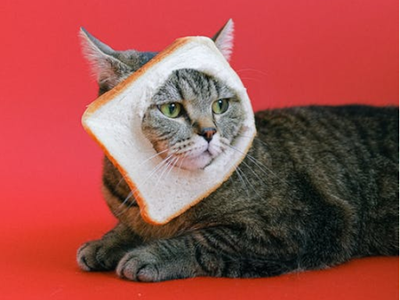
![Associated image for Best food for Ragdoll cats in the UK [Broken Down]](http://untamed.com/cdn/shop/articles/featured_best_food_for_ragdoll_cats_uk_400x300_crop_center.jpg?v=1646818249)
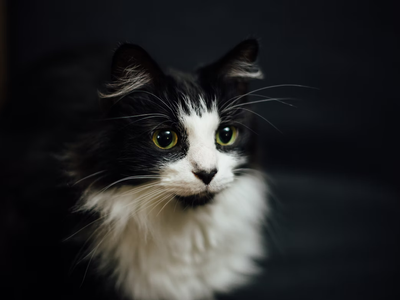
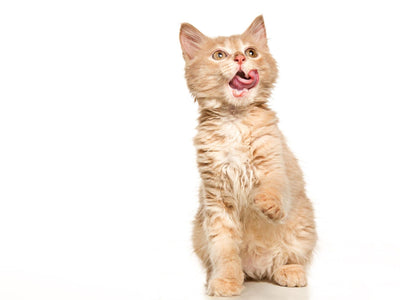

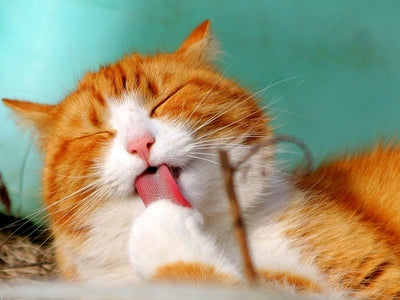
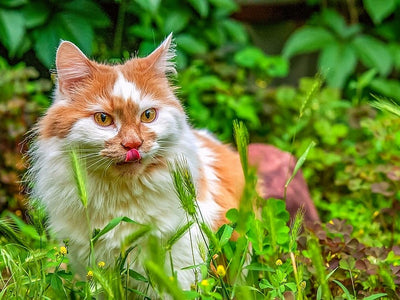

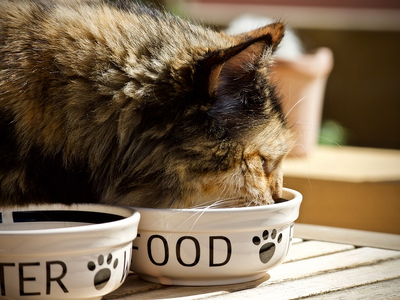
![Associated image for What human food can Sphynx cats eat? [Comprehensive list]](http://untamed.com/cdn/shop/articles/what_human_food_can_sphynx_cats_eat_Featured_400x300_crop_center.jpg?v=1648705074)

